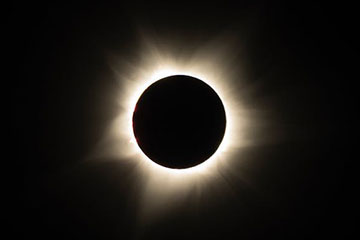
03/19/2024
One of nature’s most beautiful wonders will soon be seen by SUNY Cortland students, faculty and staff when a total solar eclipse transforms midday to dusk.
The Physics and Art and Art History departments are co-planning a viewing event for Monday, April 8, from 2 to 4 p.m. in front of Bowers Hall.
The event will offer eager eclipse fans:
- A limited supply of SUNY Cortland-branded solar eclipse glasses for safe viewing.
- Telescope viewings of the eclipse.
- Catering with pizza and wings provided by Cortland Auxiliary Services and funded by the Physics and Engineering Club.
- Two 30-minute planetarium shows at 2 and 2:30 p.m. that focus on lunar and solar eclipses, moon phases and star gazing (limited seating).
“The April 8th eclipse will be a total solar eclipse for most of CNY, and the next visible solar eclipse in the contiguous U.S. will not happen until 2044,” said Sean Nolan, a lecturer in the Physics Department and the director of the university’s planetarium.
“This unique event can serve to bring the whole campus community together. Now more than ever, we need to come together and enjoy these rare moments. We also hope that this event will build interest in astronomy and science in general.”
A total eclipse occurs when the moon lines up at the perfect distance between the sun and an area on the Earth to fully hide the sun, resulting in “totality” and a view of the sun’s outer corona. It occurs along a narrow path for a short time, making them rare. Cortland will see 99% of the sun covered by the moon’s shadow.
The entire eclipse event will take place from 2:08 to 4:34 p.m., while the maximum eclipse will be visible for a brief time in Cortland County starting at 3:23 p.m.
“Several colleagues in the Physics Department — myself, Beth Pennell, Chelsea Guy, and Zach Eridani — started brainstorming a viewing event last fall,” Nolan said. “We met with Todd Malone (director of Campus Event Management) in January to discuss the logistics of running a campuswide event.”
Looking directly at an eclipse can cause serious and permanent damage to your eyes, so all members of the SUNY Cortland community are reminded to only view the eclipse through special, protective lenses.
Glasses made specifically for solar viewing, provided for free at the viewing event, are safe, as is projecting the Sun’s image onto an indirect surface. One thousand custom eclipse glasses were bought by the Physics Department and will be provided for free. Participants can also learn more about the scientific process of a solar eclipse and how past scientists used total solar eclipses to advance scientific knowledge.
The Art Exhibition Association (AEA) plans to host a pinhole-camera-making workshop in the lead up to the eclipse. The cameras will offer a safe way to capture a lasting image of a natural wonder that won’t be seen again in the area for decades. The next total eclipse through New York state won’t occur until 2079.
“During the eclipse we will invite students and faculty to engage with the tool we created to view the eclipse in an alternate and exciting way,” said senior Chloe Loewenguth, treasurer of the Art Exhibition Association.
Some results from the cameras may be posted to the Art and Art History Department’s website for wider viewing after the eclipse.
Joining arts and sciences together isn’t as strange as it might appear, according to Wylie Schwartz, assistant professor in the Art and Art History Department and faculty advisor to the AEA.
“Any material that an artist works with, whether it be clay, glass, wood, stone, steel or even digital technologies, is inherently physical and requires an intimate knowledge of the properties of that material. Seen in this way, it makes sense to me that these fields would offer ample opportunities for collaboration.”
While the Art Exhibition Association has a list of events that includes everything from film screenings and museum trips to jewelry workshops, Schwartz said the eclipse has been a unique opportunity.
“In contemporary art practice today, creating a work of art can involve facilitating a group experience designed to call attention to something larger than oneself, and this is something the AEA club members had in mind when proposing this event,” Schwartz said. “The mythology surrounding eclipses throughout history and the technologies — like the pinhole camera — that we have created to view and capture images of the eclipse are all within the realm of the aesthetic.”